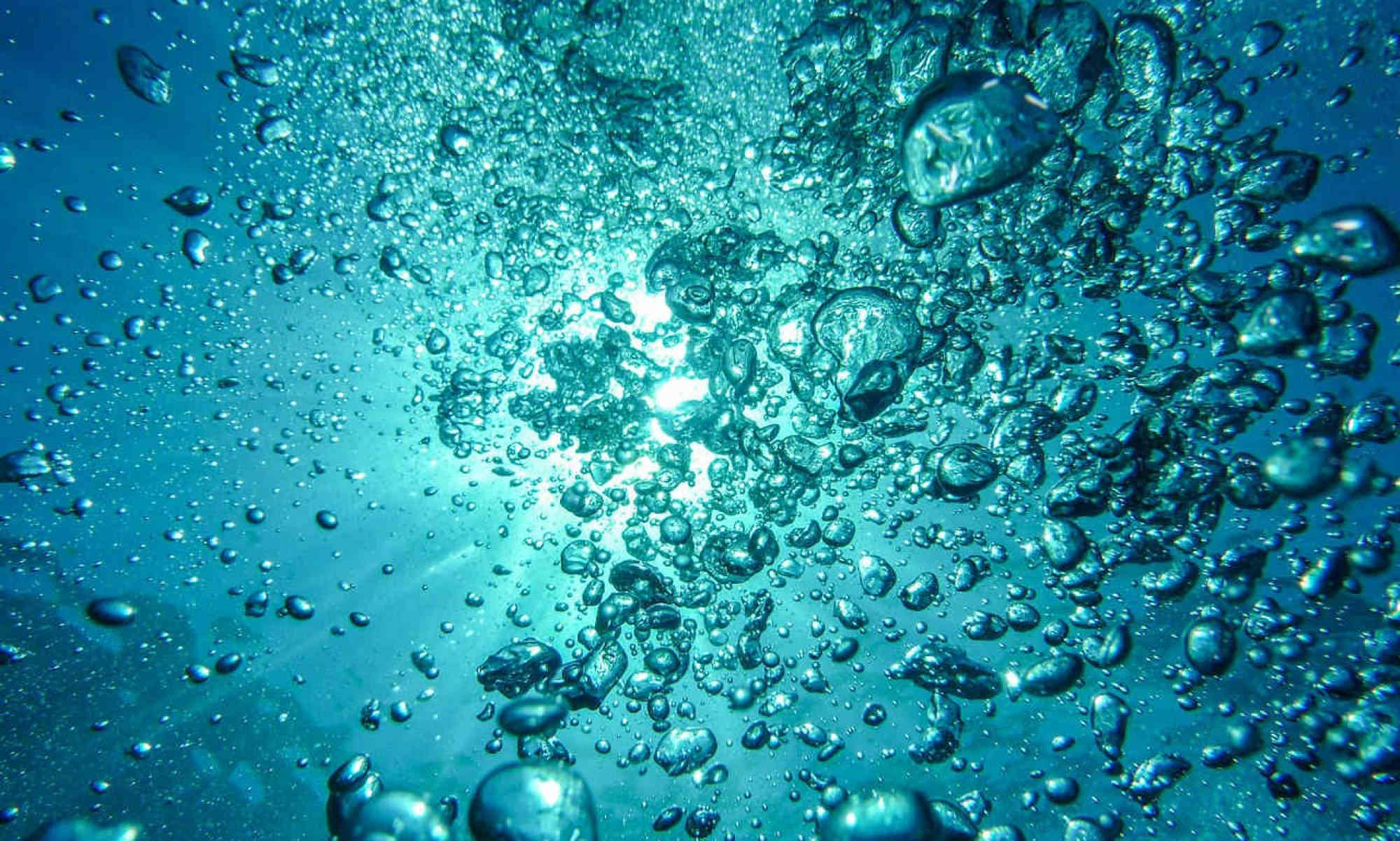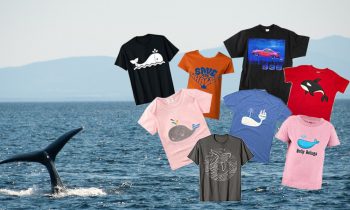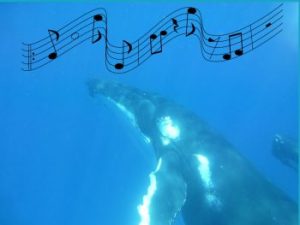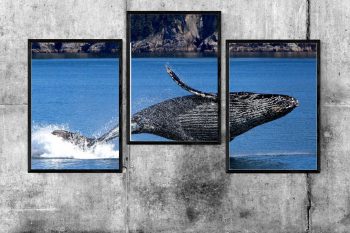Baleen Whales
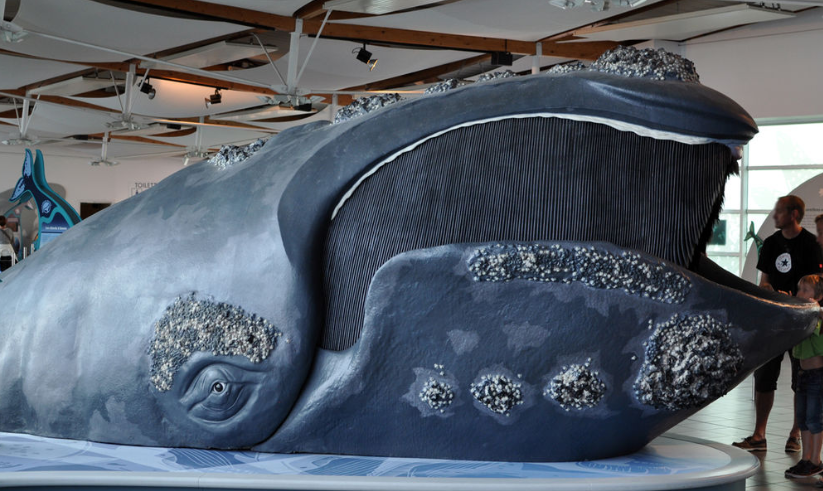
They are a very diverse group of carnivorous marine mammals that have beards instead of teeth.
Let’s analyze some species!
Bowhead Whale
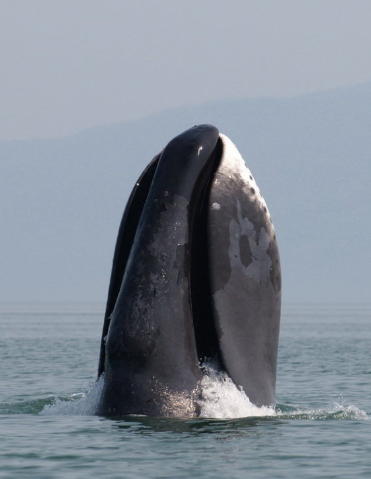
The bowhead whale was also known as the Greenland right whale or Arctic whale.
Genus: Balaena
Scientific name: Balaena mysticetus
Balaena is a genus of cetacean (whale) in the family Balaenidae. Balaena is considered a monotypic genus, as it has only a single extant species, the bowhead whale. It was first described in 1758 by Linnaeus, who at the time considered all of the right whales as a single species. Historically, both the family Balaenidae and genus Balaena were known by the common name, “right whales”, however Balaena are now known as bowhead whales.
Bowhead Whale Characteristics:
Adult bowheads are entirely black except the front part of the lower jaw which is white and prominently upturned. It is one of the largest animals on the planet. Its size can vary from 14 to almost 20 meters in length and weight from 75 to 100 tons.
Their massive bow-shaped heads are used to break thru thick sea ice up to 60 cm (23 in). A bowhead skull makes up one-third of their total length. But, that does not mean the whales swim away unscathed. Bowhead whales have many scars on their bodies from shattering ice and these markings help scientists identify individual whales.
Like other Arctic whales, narwhal and beluga, bowhead whales do not have a dorsal fin. The absence of a dorsal end allows bowhead, benefits suited to their environment, including preventing heat loss, reducing surface area, and allowing them to swim under ice sheets.
His mouth has a big lip up in the lower jaw that helps to reinforce and contain the whiskers inside his mouth. This also prevents breakage of the plates due to the pressure of the water that passes through them as it advances.
The time spent underwater in a single dive is usually limited to 9-18 minutes. Bowheads are not thought to be deep but they can reach a depth of up to 500 ft (150 m). These whales are slow swimmers, normally traveling at about 2-5 km / h. When fleeing from danger, they can travel at a speed of 10 km / h.
Bowhead Whale Social life :
Bowheads are usually solitary swimmers, but will sometimes feed in groups of up to 14 animals, which swim in a V formation. This occurs during their migration.
Size comparison:
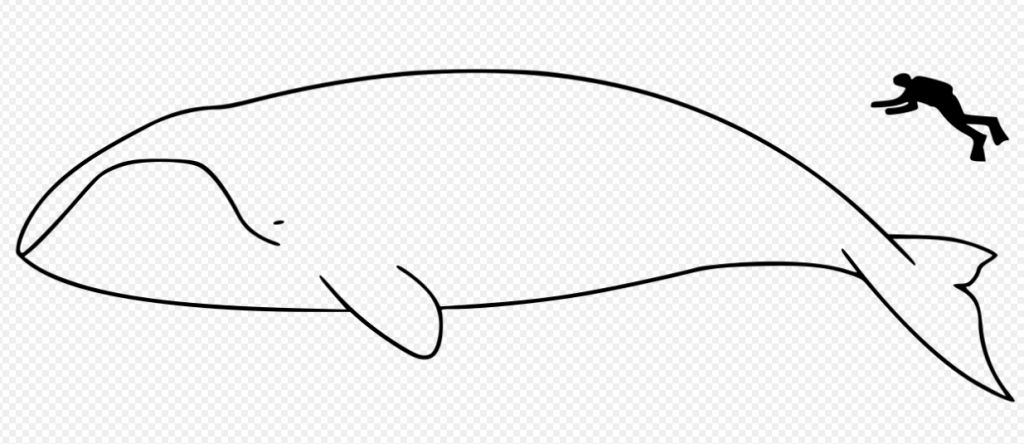
Bowhead Whale Habitat or distribution area:
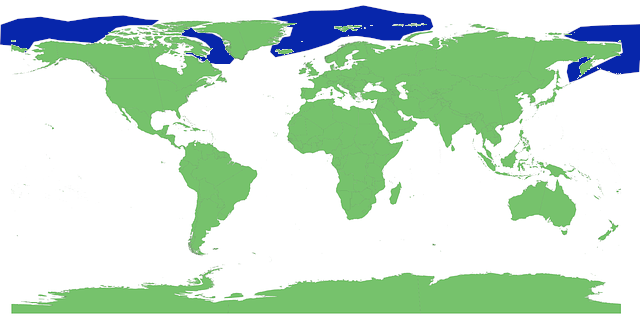
It lives in the circumpolar region of the north, often in shallow waters. The population of Alaska goes through the winter months in the southwest of the Bering Sea. They also migrate northward in the spring, following openings in the ice on the seas of Chukchi and Beaufort.
Bowhead Whale Diet:
The Bowhead whale is a bearded whale but it has a different technique than the other bearded cetaceans. The other whales have distensible ventral folds that fill with water loaded with prey, and then expel the water while they filter the prey through their beards. While the bowhead swims forward with his huge mouth open and filters through his beards.
Bowhead whales eat up to 2 tonnes of food every day. Annually should be eating up to 100 tonnes of food. The majority of their feeding takes place during the summer months in the Canadian Arctic.
Bowhead Whale Average life:
150-200 years.
How can it be?Through comparative analysis, two alleles that could be responsible for the whale’s longevity were identified. ERCC1 is linked to DNA repair as well as increased cancer resistance. PCNA is also important in DNA repair. These mutations enable bowhead whales to improve DNA damage, allowing for greater resistance to cancer. The whale’s genome may also reveal physiological adaptations such as having low metabolic rates compared to other mammals. Changes in the gene UCP1, a gene involved in thermoregulation, can explain differences in the metabolic rates in cells.
Bowhead Whale Gestation period :
The females produce a calf every 3 to 4 years, after a pregnancy 13-14 months. The newborn calf is approximately 4.5 m and weighs about 1 ton.
Bowhead Whale Age of maturity:
They reach sexual maturity at 10 to 15 years of age. Sexual activity occurs in pairs or in boisterous groups of several males and one or two females.
Bowhead Whale Status
Of the five stocks of bowhead populations, three are “endangered“, one as “vulnerable“, and one as “lower risk, conservation dependent” according to the IUCN Red List. The global population is assessed as of least concern.
Right Whales
The Right Whale got its name because it was the “right” whale to hunt-it was slow moving and floated after being killed.
Right whales are three species of large baleen whales of the genus Eubalaena:
- the North Atlantic right whale (Eubalaena glacialis),
- the North Pacific right whale (Eubalaena japonica) and
- the Southern right whale (Eubalaena australis).
Genus: Eubalaena
Right Whales Characteristics:
These whales are migratory, moving seasonally to feed or give birth. The warm equatorial waters form a barrier that isolates the northern and southern species from one another.
Right whales were a preferred target for whalers because of their docile nature, their slow surface-skimming feeding behaviors, their tendency to stay close to the coast, and their high blubber content.
During courtship, males gather into large groups to compete for a single female, suggesting that sperm competition is an important factor in mating behavior.
They are easily identifiable due to the calluses on their heads, in which live crustaceans called ciámidos, which are the ones that give the color white, they also have a V-shaped orifice, unique in comparison with other types of whales.
Right Whales Average life:
There is little data on their lifespan, but it is believed to be at least fifty years, and some may live more than a century.
Right Whales Social life:
The Right Whales live in groups of about 10 or 12 and do not have strong social ties within the groups. The specialists affirm that they live in different groups throughout their lives.
Size comparison:
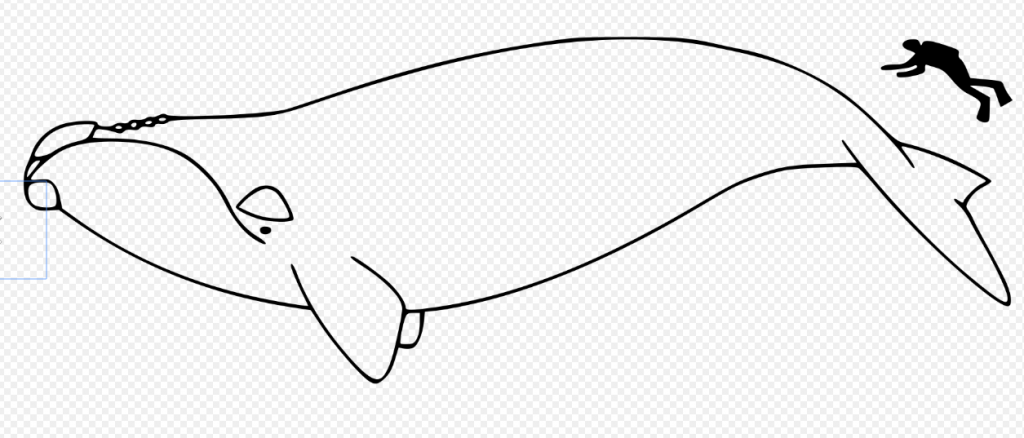
Right Whales Diet:
The right whales’ diets consist primarily of zooplankton, copepods, as well as krill, and pteropods. As with other baleens, they feed by filtering prey from the water. They swim with an open mouth, filling it with water and prey. The whale then expels the water, using its baleen plates to retain the prey. Also, they may forage the surface, underwater or even the ocean bottom.
Right Whales Gestation period:
Gestation tends to last a year, and calves are born at 1 short ton. Females only produce offspring once every 3 to 5 years.
Right Whales Age of maturity:
Maturity occurs between 7 and 12 years.
North Atlantic Right Whale
Scientific name: Eubalaena Glacialis
North Atlantic Right Whale Habitat or distribution area
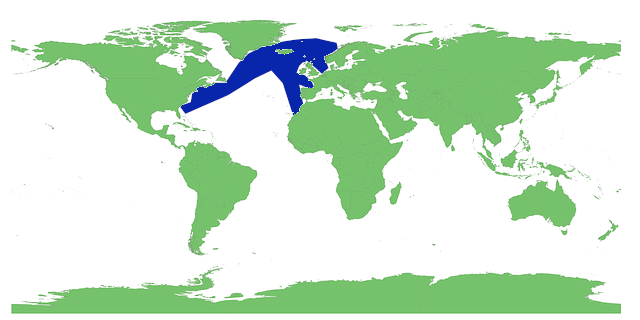
Almost all of the 400 North Atlantic right whales live in the western North Atlantic Ocean. In northern spring, summer and autumn, they feed in areas of the Canadian and northeast U.S. coasts in a range stretching from New York to Newfoundland.
Right whales’ habitat can be affected dramatically by climate changes along with Bowhead whales.
North Atlantic Right Whale Status
Endangered
An endangered species is a species which has been categorized as very likely to become extinct. Endangered (EN), categorized by the International Union for Conservation of Nature (IUCN) Red List, is the second most severe conservation status for wild populations in the IUCN’s schema after Critically Endangered (CR).
North Pacific Right Whale
The whales can only cope with the moderate temperatures found between 20 and 60 degrees in latitude.
The pectoral fins of Pacific right whale are larger in size than the other right whales and more pointed, and there may be differences in tail shape by individuals or sex. Additionally, there are differences of coloration and shape (minor) of baleen plates between the Pacific and Atlantic.
Scientific name: Eubalaena Japonica
North Pacific Right Whale Habitat or distribution area:
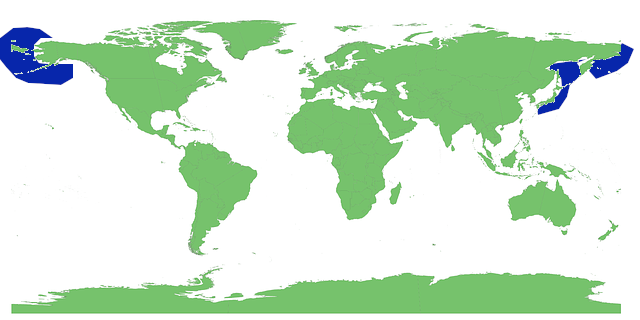
The North Pacific live in a band from Japan to Alaska and all areas of the Southern Ocean. In general, they prefer to stay close to peninsulas and bays and on continental shelves, as these areas offer greater shelter and an abundance of their preferred foods.
North Pacific Right Whale Status
Endangered
An endangered species is a species which has been categorized as very likely to become extinct. Endangered (EN), categorized by the International Union for Conservation of Nature (IUCN) Red List, is the second most severe conservation status for wild populations in the IUCN’s schema after Critically Endangered (CR).
Southern Right Whale
Scientific name: Eubalaena Australis
Southern Right Whale Habitat or distribution area:
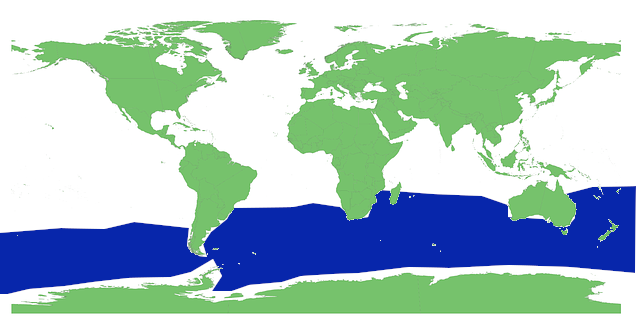
The most recent population estimates, published by National Geographic in October 2008, put the southern whale population at 10,000.
Many locations throughout the Southern Hemisphere have an ongoing presence of former Southern African countries, including the African continent, Australia, New Zealand, Brazil, Argentina, Chile, and Peru.
Southern Right Whale Status:
Least Concern
At least concern (LC) species is a species which has been categorized by the International Union for Conservation of Nature (IUCN) as evaluated but not qualified for any other category. They do not qualify as threatened, near threatened, or conservation dependent.
Gray Whale

The gray whale is a baleen whale that migrates between feeding and breeding grounds yearly. It reaches a length of 14.9 meters, a weight of 36 tonnes.
This whale carries out one of the longest migrations, making an annual round trip of 15,000-20,000km.
Genus: Eschrichtius
Scientific name: Eschrichtius robustus
Gray Whale Characteristics:
Notable features that distinguish the gray whale from other mysticetes include its baleen that is variously described as cream and is unusually short. Small depressions on the upper jaw each contain a lone stiff hair. They have bearing two to five shallow furrows on the throat’s underside. The gray whale also lacks to dorsal end, instead of bearing 6 to 12 dorsal crenulations, which are raised bumps on the midline of its rear quarter, leading to the flukes. This is known as the dorsal ridge. The tail itself is 3-3.5 m across and deeply notched at the center while its edges taper to a point.
Gray whales are active, inquisitive, friendly and often approach boats.
They have a kind of behavior in which they just raise their heads out of the water, arch their heads back as if they were sunbathing, or as if they were curious to know something.
Gray Whale Average life:
They live between 55 and 70 years.
Gray Whale Social life:
In general, the gray whale lives in small groups, from 3 to 5 members, the largest pod found had 16 members. However, they do not stay in the same group throughout their lives. Instead, they form very loose ties and move on to other groups later on.
Gray Whale Size comparison:

Gray Whale Habitat or distribution area
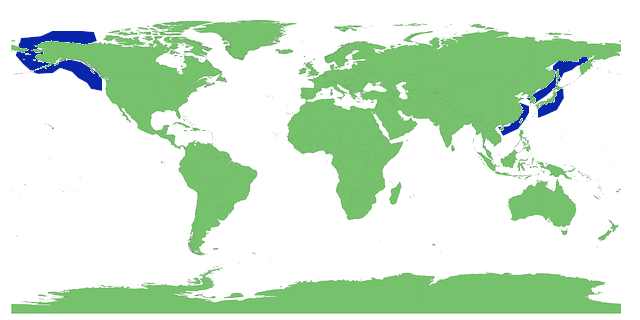
The habitat of the Gray Whale is the most coastal among the great whales, rarely venturing more than 20 to 30 km out to sea and is, for this reason, one of the most sighted whales in the world.
It is known that there are two populations in the Pacific Ocean: one of no more than 130 individuals whose migratory route is between the Sea of Okhotsk and South Korea, and a larger one with a population of between 20,000 and 22,000 individuals. the eastern Pacific traveling between the waters of Alaska and Baja California Sur.
The main feeding habitat of the western Pacific subpopulation is the shallow (5-15 m (16-49 ft) depth) Sakhalin Island, where the main prey species appears to be amphipods and isopods. In some years, the whales have also used an offshore feeding ground in 30-35 m (98-115 ft) depth of Chayvo Bay, where benthic amphipods and cumaceans are the main prey species.
Gray Whale Diet
The whale feeds mainly on benthic crustaceans, which it eats by turning on its side and scooping up sediments from the sea floor. This unique feeding selection makes gray whales one of the most important reliant on coastal waters among baleen whales. It is classified as a baleen whale which acts like a sieve, to capture small sea animals, including amphipods taken in along with water, water, and other material.
Gray Whale Gestation period:
The female gives birth only once every 2 years, usually to a single calf, after a period of 12 to 13 months of gestation.
Gray Whale Age of maturity:
They reach their sexual maturity at 8 or 9 years old.
Gray Whale Status
Least Concern
At least concern (LC) species is a species which has been categorized by the International Union for Conservation of Nature (IUCN) as evaluated but not qualified for any other category. They do not qualify as threatened, near threatened, or conservation dependent.
Humpback Whale
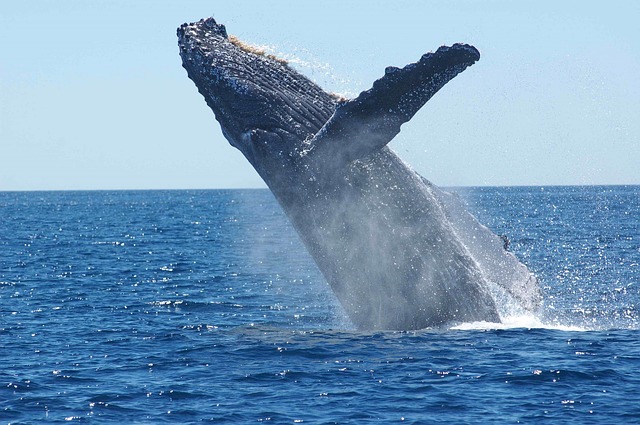
Found in oceans and seas around the world, humpback whales typically migrate up to 25,000 km (16,000 mi) each year. They feed in polar waters and migrate to tropical or subtropical waters to breed and give birth, fasting and living off their fat reserves.
The humpback whale is a species of baleen whale. One of the larger rorqual species. The adults range in length from 12–16 m (39–52 ft) and weigh around 25–30 metric tons (28–33 short tons).
Genus: Megaptera
Scientific name: Megaptera novaeangliae
Humpback Whale Characteristics:
The humpback whales are easily identifiable by their robust build, their long pectoral fins and the black coloration of their dorsal region. The pectoral fins are white on the underside and can be white or black on the upper face depending on each population or individual. It can reach up to one-third of the length of the body.
The females of the species are larger than the males. The average size in males was 13 m, while in females it was 13.9 m.
When the humpback whale emerges it expels the air from its lungs in a cloud of up to three meters in the form of cauliflower. The hot air that comes from the lungs immediately condenses in contact with the ambient cold air the water vapor that it contains.
This species of whale has between 14 and 22 grooves. These consist of a series of folds in the skin that extends through the ventral area, from the mouth to the navel.
Humpback WhaleAverage Life:
the average life is 45 to 50 years
Humpback Whale Social Life:
The humpback social structure is loose-knit. Typically, individuals live alone or in small, transient groups that disband after a few hours. Longer-term relationships between pairs or small groups, lasting months or even years, have rarely been observed. Groups may stay together longer in summer to forage and feed cooperatively.
Humpback Whale Size comparison:
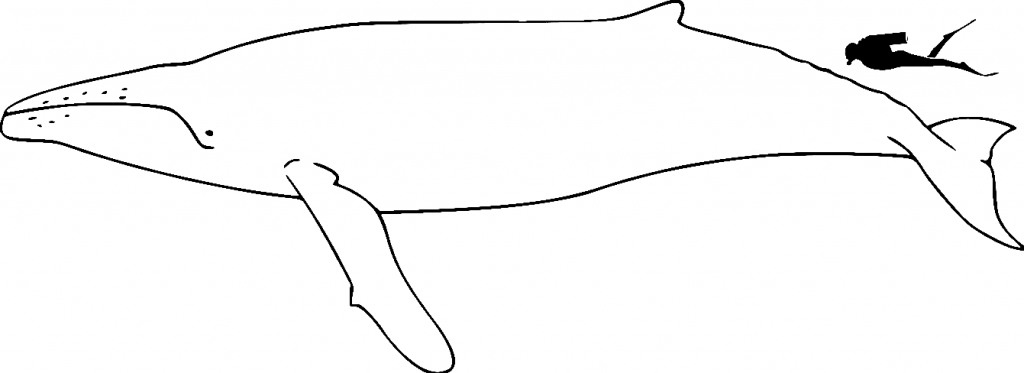
Humpback Whale Habitat or distribution area
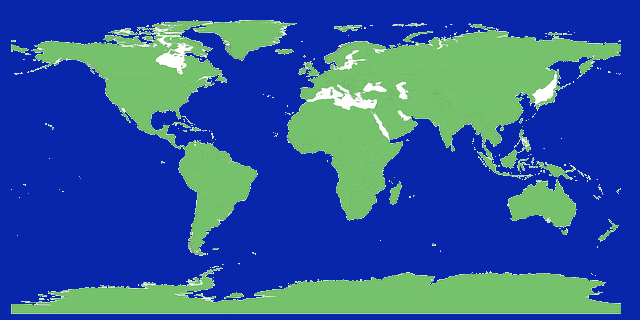
You can see the humpback in all the oceans between latitudes 60ºS to 65ºN. It is a migratory species that spends summers in cold waters of high latitudes and that reproduces in tropical or subtropical climates. They travel distances of more than 25,000 kilometers a year.
The only non-migratory population is the one that lives in the Persian Gulf. This place has increased the availability of food brought by the monsoon during the summer. That allows you to stay there all year. There are no humpbacks in the Baltic Sea or in the Arctic Ocean or in the easternmost part of the Mediterranean.
Humpback Whale Dieta:
Humpbacks feed primarily in summer and live off fat reserves during winter. The humpback is an energetic hunter, taking krill and small schooling fish such as juvenile Atlantic and Pacific salmon, herring, capelin, and American sand lance, as well as Atlantic mackerel, pollock and haddock in the North Atlantic. They feed near fish hatcheries in Southeast Alaska, feasting on salmon fry released from the hatcheries. Krill and copepods are prey species in Australian and Antarctic waters. Humpbacks hunt by direct attack or by stunning prey by hitting the water with pectoral fins or flukes.
They also use another very common way of catching their prey. The technique is known as “bubble net”, in which a group of individuals swims in concentric circles releasing bubbles through the spiracles under the schools of fish. The bubble ring surrounds the school of fish, closing progressively, gathering them in an increasingly smaller cylinder. Then, they suddenly jump on them taking a big bite and swallowing thousands of fish in one gulp. The slotted plates in the animal’s mouth allow it to easily drain all the water taken in the maneuver. The ring formed by the bubbles can be up to thirty meters in diameter and requires the cooperation of a dozen animals.
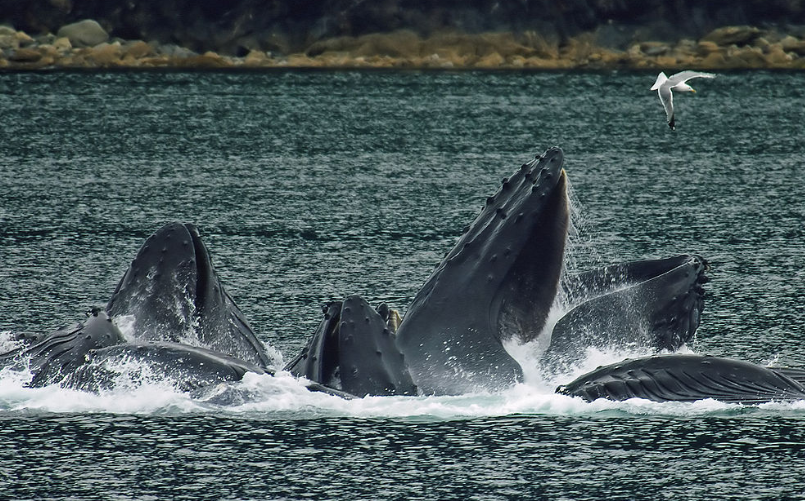
A group of whales bubble net fishing
Credit: Evadb; Edit by jjron. [Public domain]
Humpback Whale Gestation period:
The females usually give birth every two or three years. The pregnancy lasts eleven months. It is rare, but certain females can reproduce two years in a row. The calf measures at birth from four to four and a half meters and weighs approximately 700 kilos.
Age of maturity: Sexual maturity is reached between 4 and 6 years.
Humpback Whale Status:
Least Concern
At least concern (LC) species is a species which has been categorized by the International Union for Conservation of Nature (IUCN) as evaluated but not qualified for any other category. They do not qualify as threatened, near threatened, or conservation dependent.
Blue Whale
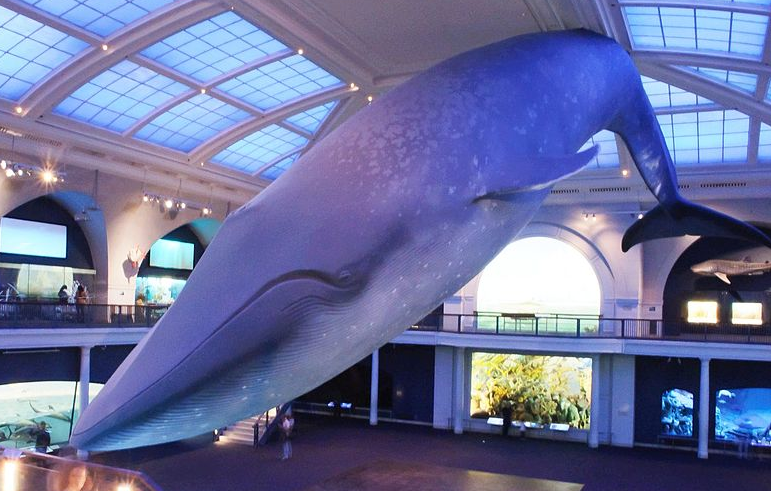
The Exhibition Lab’s blue whale at the American Museum of Natural History
Credits: InSapphoWeTrust from Los Angeles, California, USA [CC BY-SA 2.0 (https://creativecommons.org/licenses/by-sa/2.0)]
The blue whale is the largest of all the whales in the world, in fact, it is the largest animal in the world. However, it is also very thin, due to the length of its body, which allows all the weight to be distributed evenly. As a result, the blue whale can move quickly in the water.
Genus: Balaenoptera
Scientific name: Balaenoptera musculus
Blue Whale Characteristics:
Its average size is between 24 and 27 m in length and weigh between 100 and 120 tons.
To help with movement, blue whales have very long fins, averaging 10 to 13 inches long when fully developed. They are able to move at a speed of about 30 miles per hour in the water when they want though, a normal pace for these whales will be 12 miles per hour.
The tongue weighs approximately 2.7 tons and, when fully open, its mouth is large enough to hold up to 90 tons of food and water, however, despite the size of its mouth, the dimensions of its throat they are such that a blue whale can not swallow objects larger than a beach ball.
Blue Whale Average life:
They have a lifespan of 70 – 90 years they are also one of the oldest living marine mammals known to inhabit the sea.
Blue Whale Social life:
They usually live alone or as a couple, although groups of up to seven individuals can be observed. Where there are large concentrations of food, there were up to 60 specimens gathered in the same are. But it does not form large groups like other baleen species.
Blue Whale Size comparison:

Blue Whale Habitat or distribution area
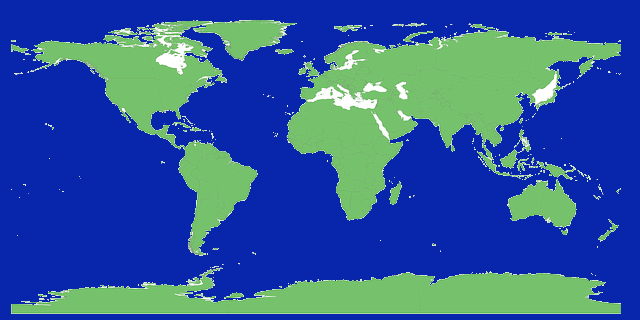
In the North Atlantic, two groups have been located.
The first is in Greenland, Newfoundland and Labrador, Nova Scotia and the Gulf of San Lorenzo, with about 500 specimens.
The second (the easternmost group was discovered in the Azores in spring and in Iceland in July and August) is supposed to follow the Mid-Atlantic Ridge between the two volcanic islands.
Beyond Iceland, they have been discovered as far north as Spitsbergen and Jan Mayen, although such observations are scarce. It is estimated that the total population of the North Atlantic is between 600 and 1500 individuals.
Blue Whale Diet:
Blue whales feed almost exclusively on krill. An adult blue whale can eat up to 40 million krill in a day.
Blue Whale Gestation period:
Females typically give birth once every two to three years at the start of the winter after a gestation period of 10 to 12 months.
Blue Whale Age of maturity:
The sexual maturity of both males and females occurs at approximately five years of age.
Blue Whale Status:
Endangered
An endangered species is a species which has been categorized as very likely to become extinct. Endangered (EN), as categorized by the International Union for Conservation of Nature (IUCN) Red List, is the second most severe conservation status for wild populations in the IUCN’s schema after Critically Endangered (CR).
Minke Whale
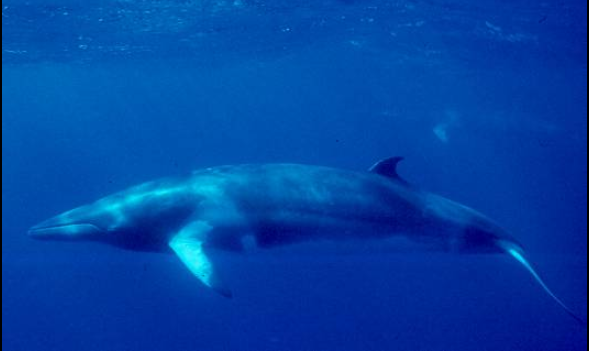
The minke whales are the second smallest baleen whale.
Genus: Balaenoptera
Scientific name: The minke whale into two species:
- Common minke whale or northern minke whale (Balaenoptera acutorostrata)
- Antarctic minke whale or southern minke whale (Balaenoptera bonaerensis)
Minke Whale Characteristics:
The minke whales are among the most robust members of their genus, the greatest height of their body being one-fifth their total length. Their prominent, upright, falcate dorsal fin averages about 30 cm and is set about two-thirds the way along the back. They are dark gray dorsally and clean white ventrally. The lower jaw projects beyond the upper jaw and is dark gray on both sides.
The minke whale has up to 70 slots in the throat area, this helps them in the process of collecting the water and the materials in it, to then filter the food.
The whale breathes three to five times at short intervals before “deep diving” for 2 to 20 minutes. A pronounced arch of the back precedes the deep dives. The maximum speed of the minkes swim is estimated at 38 km / h.
Both species undertake seasonal migration routes to the poles during spring and towards the tropics during fall and winter.
Minke Whale Average life:
Minke whales typically live for 30–50 years; in some cases they may live for up to 60 years.
Minke Whale Social life:
The minke whale is not very social. Many of them tend to live in peace, others have a partner or a group of three. It is very rare, except during migration, to see more than three individuals together.
Minke Whale Size comparison:
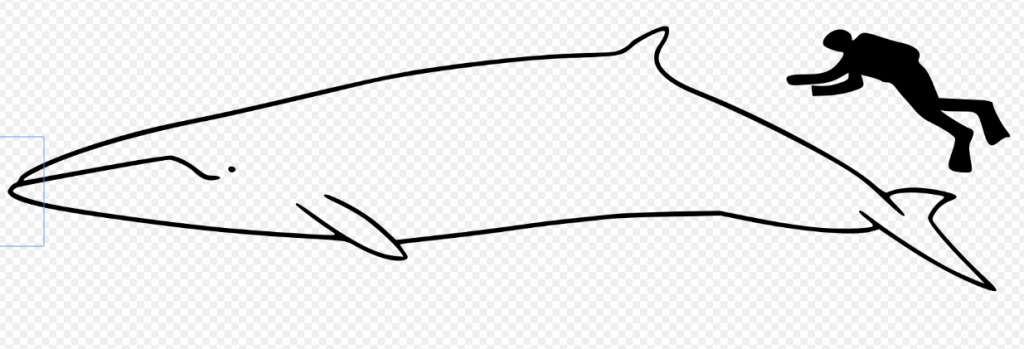
Minke Whale Habitat or distribution area
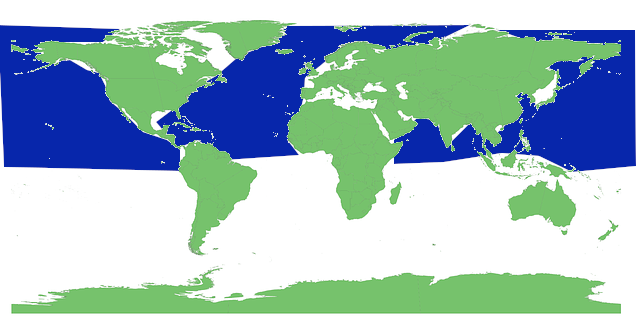
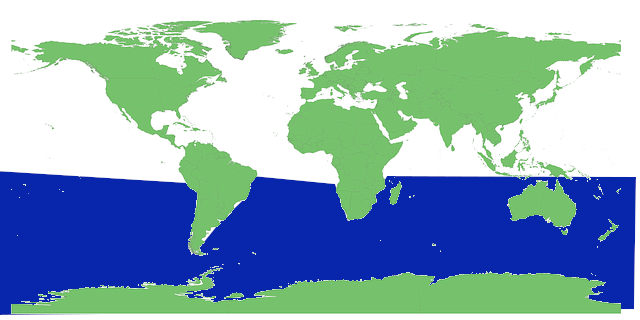
Antarctic minke whale inhabits all oceans of the southern hemisphere. During the summer it is close to Antarctica but moves further north in winter. While the Common minke whale inhabits in all the oceans of the northern hemisphere both the Atlantic and Pacific oceans.
Minke Whale Diet:
Their diet consists mainly of krill, small fish, herring and cod. They move about 6 miles per hour when they are feeding.
Minke Whale Gestation period:
The calving interval is estimated to be about 12.5 to 14 months and the gestation period of 10 months.
Minke Whale Age of maturity:
The sexual maturity is 6–8 years of age.
Minke Whale Status:
The Antarctic minke whale is currently considered Near Threatened by the IUCN red list. However, the IUCN states that the population size is “clearly in the hundreds of thousands”
The common minke whale is considered “Least Concern” on the IUCN red list.
Fin Whale
The fin whale is known as finback whale or common rorqual. In size, this animal is the second largest existing on the planet, only surpassed by the blue whale. It can reach a length of 27 meters.
Genus: Balaenoptera
Scientific name: Balaenoptera philasus
Fin Whale Characteristics:
The common fin is characterized by its large size and its slender body. The average size of males and females of the species is 19 and 20 meters, respectively. Fin whales of the northern hemisphere reach a smaller size than the Antarctic subspecies and females are larger than males. There are still no records of the weighing of an adult specimen, but it is estimated that a 25-meter adult weighs around 70 tons.
The upper part and the sides are brownish gray and the lower part is whitish. It has a pointed snout, double spiracles.
It has a white mark to the right of the lower jaw and on the beards on the same side, while the left side is ashen or black. This asymmetry is universal in the rorqual common and unique among cetaceans, being one of the key characteristics to identify this species.
When the whale surfaces, the dorsal fin is visible soon after the spout,but generally they do not take the tail out of the water. Then they dive to depths of 250 meters or more to feed. The spout is vertical and narrow and can reach heights of 6m or more.
When it reaches the surface, the dorsal fin becomes visible immediately after expelling through its spiracles a vertical and narrow jet of water that can reach six meters in height or even more.
For its speed the Fin whale the nickname “the greyhound of the sea”.
Fin Whale Average life:
They have a maximum life span of at least 94 years of age, although specimens have been found aged at an estimated 135–140 years.
Fin Whale Social life:
They usually live in groups of six to ten individuals, although in feeding areas it is possible to observe up to 100 individuals together.
Fin Whale Size comparison:

Fin Whale Habitat or distribution area

At least two recognized subspecies exist, in the North Atlantic and the Southern Hemisphere. It is found in all the major oceans, from polar to tropical waters. It is absent only from waters close to the ice pack at the poles and relatively small areas of water away from the open ocean. The highest population density occurs in temperate and cool waters.
Fin Whale Diet:
The fin whale is a filter feeder that feeds on small schools of fish, squid, crustaceans such as the Misidáceos and krill, feeds by opening its jaws while swimming at a relatively high speed, since according to recent studies it reaches 11 kilometers per hour, which makes it gobble up more than 70 cubic meters of water in each ingestion. Then it closes the jaws and pushes the water back out through the barbs, allowing the water to come out while capturing the prey.
Fin Whale Gestation period:
They have a gestation period of 11 to 12 months, and the females reproduce every 2 or 3 years.
Fin Whale Age of maturity:
Females reach sexual maturity between 6 and 12 years.
Full physical maturity is attained between 25 and 30 years.
Fin Whale Status:
Vulnerable
A vulnerable species is one which has been categorized by the International Union for Conservation of Nature as likely to become endangered unless the circumstances that are threatening its survival and reproduction improve.
You may also like…
In ofWhale.com you can find the online whale toys you’re looking for, like baby shark toys, stuffed toys or a whale bath toy. Let’s get started with the selected gallery or check more options on the links.
In our world, whales have a great message to transmit to humanity and we agree with them. For you and for your children choose the whale t-shirts best fits your message
Most people loves whales enjoy using CDs with the whale sounds , whale songs and sounds of the waves to obtain a peaceful and restful sleep, perform meditation and relaxation.
Ofwhale.com is the right place where you can get the whale pictures you deserve for your home. Read more about the feelings you convey and the styles you can choose.

